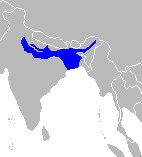Ganges shark
| Ganges shark | |
|---|---|
 |
|
| Scientific classification | |
| Kingdom: | Animalia |
| Phylum: | Chordata |
| Class: | Chondrichthyes |
| Subclass: | Elasmobranchii |
| Superorder: | Selachimorpha |
| Order: | Carcharhiniformes |
| Family: | Carcharhinidae |
| Genus: | Glyphis |
| Species: | G. gangeticus |
| Binomial name | |
|
Glyphis gangeticus (J. P. Müller & Henle, 1839) |
|
 |
|
| Glyphis gangeticus inhabits the Ganges-Hooghly River system | |
| Synonyms | |
|
|
The Ganges shark (Glyphis gangeticus) is a critically endangered species of requiem shark found in the Ganges River and the Brahmaputra River of India. It is often confused with the more common bull shark (Carcharhinus leucas), which also inhabits the Ganges River and is sometimes incorrectly referred to as the Ganges shark. Unlike bull sharks, which need to migrate to salt water to reproduce, species in the genus Glyphis are true river sharks. The genus contains a total of six known species, only half of which are described. In contrast, genetic evidence has shown that both the Borneo river shark (G. fowlerae) and Irrawaddy river shark (G. siamensis) should be regarded as synonyms of the Ganges shark, expanding the range of the species to Pakistan, Myanmar, Borneo and Java. Even with this expanded range, the species remains very poorly known and very rare.
G. gangeticus is a little-known species that is yet to be adequately described. Its size at birth is 56 to 61 cm, growing to an estimated 178 cm at maturity, with a maximum size of about 204 cm. It is worth noting that the size at birth or maturity is unknown for any other Glyphis species.
A typical requiem shark in its external appearance, it is stocky, with two spineless dorsal fins and an anal fin. The first dorsal fin originates over the last third of the pectoral fins, with a free rear tip that is well in front of the pelvic fins. The second dorsal fin is relatively large, but much smaller than the first (about half the height). The anal fin is slightly smaller than the second dorsal fin and the pectoral fins are broad. There is a longitudinal upper precaudal pit, but no interdorsal ridge. It is uniformly grey to brownish in color, with no discernible markings.
...
Wikipedia

